Joyce Elson Moore's Blog, page 3
December 10, 2010
More Museum Mysteries
Before long, the Mysteries at the Museum series will be complete, but for now here's another episode for Tuesday, Dec. 14 on the Travel Channel. Hope my readers are enjoying these programs, which delve into some fascinating subjects about our history.
Mysteries at the Museum: Volume 7
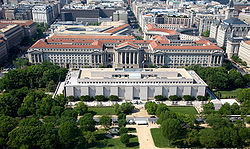 National Museum of American History
National Museum of American History
Gerald R. Ford Museum: At the Gerald R. Ford Presidential Museum, a vintage tape recorder from the 1970s was used inside America's most important Executive Office. What incriminating conversations did this machine record? And how would it ultimately help destroy an American President?
The National Museum of Nuclear Science and History: The National Museum of Nuclear Science and History houses a small antique vial which lies at the center of one of America's strangest medical mysteries. The vial once held a drug known as Radithor, and some doctors touted it as the "greatest therapeutic force known to mankind", but this revolutionary medicine was really a potion of death.
National Museum of American History: On display at the Smithsonian's National Museum of American History, is a relic from a volatile era in American history. It appears to be an ordinary restaurant lunch counter accompanied by four fading vinyl chairs. How did this lunch counter becomes center stage in an event that would help overturn centuries of oppression, and change America forever?
The Museum of Science and Industry: Inside Chicago's Museum of Science and Industry there's a giant World War Two Submarine. It's a German "U-Boat", known by its infamous number, 5-0-5. But during the war U-505 mysteriously vanished. How did U-505 end up in Chicago, and how did its sudden disappearance from battle nearly 70 years ago help bring Germany's invincible U-Boat fleet to its knees?
New Jersey State Police Museum: Secured inside the NJ State Police Museum, sealed in plastic, is a faded piece of paper. It's inscribed in dark ink, in sloppy handwriting, and it's stamped with a curious insignia. At first glance, this seventy eight year old document looks inconsequential, but it sparked one of the biggest manhunts in American history. Was the person who wrote this note ever brought to justice?
Ruidoso River Museum: At the River Museum there's an artifact from one of the most famous western tales ever told. It's a Colt Thunderer revolver. The polished, ornately etched pistol was presented to one of New Mexico's most famous Sheriffs, Pat Garrett… as a reward for killing America's most legendary outlaw, Billy the Kid. But did Pat Garrett really kill the 'Kid'?

Mysteries at the Museum: Volume 7
 National Museum of American History
National Museum of American HistoryGerald R. Ford Museum: At the Gerald R. Ford Presidential Museum, a vintage tape recorder from the 1970s was used inside America's most important Executive Office. What incriminating conversations did this machine record? And how would it ultimately help destroy an American President?
The National Museum of Nuclear Science and History: The National Museum of Nuclear Science and History houses a small antique vial which lies at the center of one of America's strangest medical mysteries. The vial once held a drug known as Radithor, and some doctors touted it as the "greatest therapeutic force known to mankind", but this revolutionary medicine was really a potion of death.
National Museum of American History: On display at the Smithsonian's National Museum of American History, is a relic from a volatile era in American history. It appears to be an ordinary restaurant lunch counter accompanied by four fading vinyl chairs. How did this lunch counter becomes center stage in an event that would help overturn centuries of oppression, and change America forever?
The Museum of Science and Industry: Inside Chicago's Museum of Science and Industry there's a giant World War Two Submarine. It's a German "U-Boat", known by its infamous number, 5-0-5. But during the war U-505 mysteriously vanished. How did U-505 end up in Chicago, and how did its sudden disappearance from battle nearly 70 years ago help bring Germany's invincible U-Boat fleet to its knees?
New Jersey State Police Museum: Secured inside the NJ State Police Museum, sealed in plastic, is a faded piece of paper. It's inscribed in dark ink, in sloppy handwriting, and it's stamped with a curious insignia. At first glance, this seventy eight year old document looks inconsequential, but it sparked one of the biggest manhunts in American history. Was the person who wrote this note ever brought to justice?
Ruidoso River Museum: At the River Museum there's an artifact from one of the most famous western tales ever told. It's a Colt Thunderer revolver. The polished, ornately etched pistol was presented to one of New Mexico's most famous Sheriffs, Pat Garrett… as a reward for killing America's most legendary outlaw, Billy the Kid. But did Pat Garrett really kill the 'Kid'?
Published on December 10, 2010 10:57
December 3, 2010
Museum Mysteries
 Isabella Stuart Gardner MuseumHi Readers: Here, as promised, is the next volume in the Travel Channels' Tuesday night show, Mysteries at the Museum.
Isabella Stuart Gardner MuseumHi Readers: Here, as promised, is the next volume in the Travel Channels' Tuesday night show, Mysteries at the Museum. Evergreen Aviation and Space Museum: Inside a giant airplane hangar at the Evergreen Aviation and Space Museum, there's a flying machine whose size and reputation dwarfs all others, but this one of a kind aircraft never flew a single mission. In fact, many believed it couldn't fly at all. So why was the "Spruce Goose" even built?
The Field Museum of Natural History: The star attraction at Chicago, Field Museum is a Tyrannosaurus Rex skeleton named "Sue". It is the largest most complete T-Rex skeleton ever found, and this makes Sue the key piece of evidence in unraveling a mystery that has baffled scientists since the very first T-Rex fossil was discovered in 1902… What was life like for the world's largest prehistoric predator?
William McKinley Presidential Museum: The William McKinley Presidential Museum houses a nightshirt once worn by McKinley that bears a a tear down the back. How did this tear come to be? The answers lie within the mystery of President McKinley's final moments – a tragic demise that changed the history of the Presidency.
Isabella Stewart Gardner Museum of Art: Hanging amid fantastic works of art by Michelangelo, Rembrandt, Matisse and numerous others at this museum, are four empty picture frames. These frames hang as symbolic reminder of a shocking crime, and a 20 year old hunt to find out who was behind the biggest art heist in US history.
Johnstown Flood Museum: At a Pennsylvanian museum that's dedicated to preserving the city's rich cultural heritage, a 19th century brass pocket watch actually holds one of the Nations' most unforgettable stories. It all begins with the time frozen on the watch's face- a time that changed America forever.
Strong National Museum of Play: Not far from the shores of Lake Ontario in Rochester, New York, a museum is dedicated solely to the study of play, and one item here was actually an accidental byproduct of America's involvement in a global war. Can you guess what childhood favorite this could be?
Find out the answers to these questions and more by tuning-in to Mysteries at the Museum Tuesday at 9 E/P on Travel Channel. Enjoy the show, and secrets that will be revealed.
Published on December 03, 2010 11:14
November 30, 2010
An Interview with Patricia Stoltey
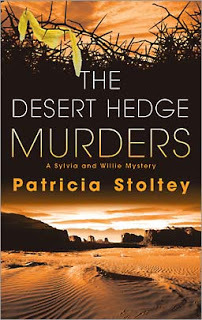 Today I welcome author Patricia Stoltey to my Historical Fiction blog. Readers, pull up a chair and let's talk about books.
Today I welcome author Patricia Stoltey to my Historical Fiction blog. Readers, pull up a chair and let's talk about books. Joyce: Hi Pat, and thanks for taking the time from your busy schedule to answer some questions for our readers. I'm always curious as to when an author began writing, and how long it took to get published.
Pat: We're not going to count the box of really bad poetry and short stories I wrote in my 20s and 30s, are we? My first attempt at a novel was The Troubleshooter, an action-adventure tale my brother and I wrote in the mid-80s. That book never made it to print, but Books in Motion turned the umpteenth revision into an audiobook in 1999. That only took thirteen years. Not bad for a first novel. The first draft of my second novel, an attempt at international intrigue and suspense, sits on a table in my office, waiting for me to decide it's worth a rewrite from beginning to end.
My writing life improved in fall 2003. I'd retired from a demanding job in the real world and realized I had to find more to do than read novels and crochet afghans, I took a novel-writing class from a local author. When the class was over, several of the attendees got together and formed a critique group. The novel I started for that class was The Prairie Grass Murders, published in hardcover in 2007.
Joyce: How did you break into publishing, Pat?
Pat: After completing the4th draft of The Prairie Grass Murders, I unsuccessfully pitched it to an agent at the 2004 Rocky Mountain Fiction Writers Colorado Gold Conference. After a few more queries also proved unsuccessful, I did another major revision, then pitched that 5th draft during a critique workshop at the 2005 conference. This time I received valuable feedback from the editor running the workshop, as well as an invitation to submit after revising the manuscript once again. Draft number six was the winner. My contract with Five Star/Gage led to a hard cover edition aimed at the library market.
The Prairie Grass Murders was also an audiobook with Books in Motion and a mass market paperback reprint with Harlequin Worldwide. The second Sylvia and Willie mystery, The Desert Hedge Murders, is now available in hard cover and as a Harlequin paperback.
Joyce: What genre or sub-genre do you write? Why did you choose this genre?
Pat: I focused on amateur sleuth mysteries for my first two books. I read a lot of mysteries and admired the way good authors think up plot twists, plant clues, and create great characters. I kept wondering if I could do that, so I finally gave it a try. I discovered it's not as easy as it looks.
Joyce: (laughing). Nothing ever is, is it? So, tell us how much time you devote to writing each day.
Pat: I don't write every day and that's a problem I'm trying to overcome. After our books are published, we often get caught up in book promotion and spend way too much time at social media, personal appearances, conferences, and other opportunities to connect with readers. In the past, I've called myself a binge writer because I spend months thinking about a book without putting anything on paper, and then sit down and write like crazy until I finish a first draft. Lately, I haven't even done that. It took me more than a year to get the revisions done on my last novel so I could start submitting to agents.
Joyce: Can we get a sneak peek at what you're working on now?
Pat: Doing the queries and submissions for a historical women's fiction, which has a working title of Wishing Caswell Dead. I'm clearing up my schedule and cleaning my desk. I have the first draft of a suspense novel sitting on the floor, waiting for my subconscious to tell me how to fix problems with the plot. And I have that idea in the works for a new Sylvia and Willie mystery. I'm still keeping up with my blog, my work with Northern Colorado Writers which includes starting a new critique group next month, and doing guest spots for blogger friends.
Remember when I said I had retired from a demanding job in the real world? I'm working harder now than I ever did before, but I will admit, I love every minute of it.
Joyce: How do you write? Are you a pantser or a plotter? Is it your characters or your plot that influences you the most?
Pat: Mostly I'm a pantser. If I have a complicated plot, I'll lay out the chapters with two or three sentences as a guide to what needs to happen at that stage of the story, but I never stick to the plan. Characters have a way of leading us down new and interesting paths as we write.
When I started the Sylvia and Willie mystery series, the setting came first because I wanted part of the story to take place in Illinois where I grew up. The plot idea came from the setting, and the characters fell into place last. With the second novel in the series, I already had the characters, so the plot developed from the protagonists' family relationships.
Wishing Caswell Dead followed a completely different path. The main character came first.
Joyce: What was the most usual way you came up with a story idea? What made you think, 'hey, I could make that into a story?'
Pat: The historical, Wishing Caswell Dead. First I had a dream about a thirteen-year-old girl in a dated photo. It looked like a tintype. I played with ideas about that girl's life and turned the dream into a short story about young Jo Mae Proud. When I reread the story after receiving a few rejections from magazines, I realized I had a whole long list of questions about the other characters and what would happen to Jo Mae after the story ended. Now her tale is a 66,000 word novel. Of all the things I've written so far, this one is my favorite.
Joyce: I'm wondering how you do research for your books. Also, what's the most interesting bit of research you've come across?
Pat: Back in the 80s when I was working on The Troubleshooter, I spent hours and hours in a university library. Times have changed. Now I do most of my research online. However, my investigations for Wishing Caswell Dead led me to a small prairie museum near Mahomet, Illinois, where I saw actual tools and furniture and farm equipment used in the 1800s. That's a lot better than looking at pictures in a book or on the Internet.
The most interesting bit of research? I think it was the time I spent learning about the Kickapoo Indian Tribe. Kickapoo artifacts figured in the plot for The Prairie Grass Murders. And there's a Kickapoo character in Wishing Caswell Dead. This tribe had a fascinating history as they moved from Wisconsin into Illinois and then across the Mississippi to a reservation in Kansas and other settlements in Mexico, yet we don't read that much about them in Native American history.
Joyce: Thanks for talking with us about your books and your writing career. The Desert Hedge Murders has an intriguing title. I think I'll start with that one first, and good luck with your next book.
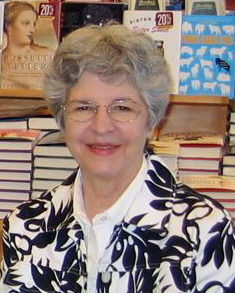 Pat: It was my pleasure joining you today, Joyce. I hope your readers will drop by my blog (http://patriciastoltey.blogspot.com/ ) from time to time to see what's going on in my writing life. I feature guest author/bloggers from a variety of genres on Thursdays, so it's a good place to find that next book to read. I'm on Facebook as Patricia Stoltey, and I'm also a big Twitter fan: @PStoltey.
Pat: It was my pleasure joining you today, Joyce. I hope your readers will drop by my blog (http://patriciastoltey.blogspot.com/ ) from time to time to see what's going on in my writing life. I feature guest author/bloggers from a variety of genres on Thursdays, so it's a good place to find that next book to read. I'm on Facebook as Patricia Stoltey, and I'm also a big Twitter fan: @PStoltey.
Published on November 30, 2010 01:30
November 29, 2010
More Mysteries at the Museum
Here, for my readers, is a taste of what will be on tomorrow night's Travel Channel series, Mysteries at the Museum. Image Image is of the Old Red Museum in Dallas, TX.
 Mysteries at the Museum: Volume 5
Mysteries at the Museum: Volume 5
Old Red Museum: In the collection of the Old Red Museum in Dallas, there's a 44-caliber rifle with a sawed off stock. It looks like many weapons that have been modified by criminals, but it's possible that this rifle may have been used in an infamous crime spree. Can you guess who the legendary criminal may be?
National Museum of the Marine Corps: In Quantico, Virginia at the National Museum of the Marine Corps, a tattered flag from World War Two's epic battle for Iwo Jima became the subject of the Nation's most famous war photograph. How did this Pulitzer Prize winning picture alter history and why do some people suspect that it isn't everything it claims to be?
National Railroad Museum: The National Railroad Museum in Green Bay, Wisconsin houses an ultra-modern locomotive known as the Aerotrain. When it was unveiled in 1956, it was supposed to change the way Americans traveled. So what derailed this futuristic locomotive, and why aren't we all riding Aerotrains today?
Scripps Institute of Oceanography: Behind the scenes at the Birch Aquarium in San Diego, there are specimens that hail from a realm nearly a mile underwater. They are rare and mysterious organisms that survive in an uncharted frontier known as the Abyss. Can you even imagine what these deep sea creatures could be?
Library of Congress: In the Library of Congress, a tattered diary provokes one of exploration's fiercest debates; who was the first person to actually reach the North Pole?
National Museum of the United States Air Force: The National Museum of the United States Air Force displays an artifact that paved the way for the exploration of man's final frontier. At the height of the Cold War, was a team of aeronautical engineers able to create a parachute system that would produce a safe, high altitude aircraft?
Enjoy the show!
 Mysteries at the Museum: Volume 5
Mysteries at the Museum: Volume 5Old Red Museum: In the collection of the Old Red Museum in Dallas, there's a 44-caliber rifle with a sawed off stock. It looks like many weapons that have been modified by criminals, but it's possible that this rifle may have been used in an infamous crime spree. Can you guess who the legendary criminal may be?
National Museum of the Marine Corps: In Quantico, Virginia at the National Museum of the Marine Corps, a tattered flag from World War Two's epic battle for Iwo Jima became the subject of the Nation's most famous war photograph. How did this Pulitzer Prize winning picture alter history and why do some people suspect that it isn't everything it claims to be?
National Railroad Museum: The National Railroad Museum in Green Bay, Wisconsin houses an ultra-modern locomotive known as the Aerotrain. When it was unveiled in 1956, it was supposed to change the way Americans traveled. So what derailed this futuristic locomotive, and why aren't we all riding Aerotrains today?
Scripps Institute of Oceanography: Behind the scenes at the Birch Aquarium in San Diego, there are specimens that hail from a realm nearly a mile underwater. They are rare and mysterious organisms that survive in an uncharted frontier known as the Abyss. Can you even imagine what these deep sea creatures could be?
Library of Congress: In the Library of Congress, a tattered diary provokes one of exploration's fiercest debates; who was the first person to actually reach the North Pole?
National Museum of the United States Air Force: The National Museum of the United States Air Force displays an artifact that paved the way for the exploration of man's final frontier. At the height of the Cold War, was a team of aeronautical engineers able to create a parachute system that would produce a safe, high altitude aircraft?
Enjoy the show!
Published on November 29, 2010 09:00
November 18, 2010
Mysteries at the Museum
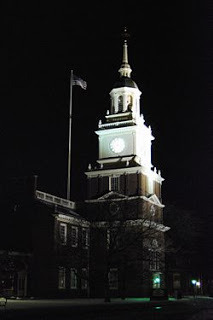 Clock Tower of Henry Ford Museum The Travel Channel has an ongoing program on Tuesdays that takes the viewer to different museums to witness the strange and unexplained. For those of you who are fond of mysteries, or museums, like I am, here are the upcoming museum spotlights for next Tuesday's show, the 4th in this very interesting series.
Clock Tower of Henry Ford Museum The Travel Channel has an ongoing program on Tuesdays that takes the viewer to different museums to witness the strange and unexplained. For those of you who are fond of mysteries, or museums, like I am, here are the upcoming museum spotlights for next Tuesday's show, the 4th in this very interesting series.
Mysteries at the Museum: Volume 4
The History Museum at the Castle: In the History Museum at the Castle in Appleton, Wisconsin, a plaster bust is modeled after Harry Houdini, who has long passed on but whose mysterious talents still baffle the mind. Is it possible that this bust is actually possessed by the spirit of this famous magician? The answer lies in the suspicious circumstances that surround Houdini's death.
The Henry Ford Museum: In Michigan, the Henry Ford Museum showcases an artifact that soared high above the roadways in 1926- a unique airplane named "The Josephine Ford". At the time, the intrepid pilot of this airplane set out on a death defying flight to the end of the earth with one goal in mind. What was this pilot's goal and why is his journey still shrouded in mystery?
Coos Historical and Maritime Museum: Located on Oregon's rugged Coast at the Coos Historical and Maritime Museum, there is a peculiar object that looks like a piece of faming equipment, but in fact, it's actually a piece from a diabolical weapon of mass destruction sent here by America's former enemy. How did this artifact cause the only deaths resulting from enemy action to occur on mainland America during World War II?
The Chicago History Museum: A plain scrap of fabric, emblazoned with a striking design located at the Chicago History Museum was one of the banners designed for protests at the infamous 1968 Democratic National Convention in Chicago. Who made this flag and how did it play such a large role in changing the direction of our country?
Fall River Historical Society: The Fall River Historical Society in Fall River, Massachusettes houses an artifact that may have been the murder weapon in one of the most notorious unsolved murders in American history. This hatchet head was the key piece of evidence used against Lizzie Borden in the murders of her parents; but did she really commit the heinous crime?
National Museum of American History: Among the many thousands of objects at the National Museum of American History at the Smithsonian Institution, is a worn and weathered eighty year old briefcase. This attache once belonged to a lifelong politician and diplomat and held countless, top secret and sensitive government documents. Why do curators at the Smithsonian believe this briefcase was party to one watershed event that changed the history of the planet?
I'll be posting the next volume later, so you can see what's coming after this.
 Clock Tower of Henry Ford Museum The Travel Channel has an ongoing program on Tuesdays that takes the viewer to different museums to witness the strange and unexplained. For those of you who are fond of mysteries, or museums, like I am, here are the upcoming museum spotlights for next Tuesday's show, the 4th in this very interesting series.
Clock Tower of Henry Ford Museum The Travel Channel has an ongoing program on Tuesdays that takes the viewer to different museums to witness the strange and unexplained. For those of you who are fond of mysteries, or museums, like I am, here are the upcoming museum spotlights for next Tuesday's show, the 4th in this very interesting series. Mysteries at the Museum: Volume 4
The History Museum at the Castle: In the History Museum at the Castle in Appleton, Wisconsin, a plaster bust is modeled after Harry Houdini, who has long passed on but whose mysterious talents still baffle the mind. Is it possible that this bust is actually possessed by the spirit of this famous magician? The answer lies in the suspicious circumstances that surround Houdini's death.
The Henry Ford Museum: In Michigan, the Henry Ford Museum showcases an artifact that soared high above the roadways in 1926- a unique airplane named "The Josephine Ford". At the time, the intrepid pilot of this airplane set out on a death defying flight to the end of the earth with one goal in mind. What was this pilot's goal and why is his journey still shrouded in mystery?
Coos Historical and Maritime Museum: Located on Oregon's rugged Coast at the Coos Historical and Maritime Museum, there is a peculiar object that looks like a piece of faming equipment, but in fact, it's actually a piece from a diabolical weapon of mass destruction sent here by America's former enemy. How did this artifact cause the only deaths resulting from enemy action to occur on mainland America during World War II?
The Chicago History Museum: A plain scrap of fabric, emblazoned with a striking design located at the Chicago History Museum was one of the banners designed for protests at the infamous 1968 Democratic National Convention in Chicago. Who made this flag and how did it play such a large role in changing the direction of our country?
Fall River Historical Society: The Fall River Historical Society in Fall River, Massachusettes houses an artifact that may have been the murder weapon in one of the most notorious unsolved murders in American history. This hatchet head was the key piece of evidence used against Lizzie Borden in the murders of her parents; but did she really commit the heinous crime?
National Museum of American History: Among the many thousands of objects at the National Museum of American History at the Smithsonian Institution, is a worn and weathered eighty year old briefcase. This attache once belonged to a lifelong politician and diplomat and held countless, top secret and sensitive government documents. Why do curators at the Smithsonian believe this briefcase was party to one watershed event that changed the history of the planet?
I'll be posting the next volume later, so you can see what's coming after this.
Published on November 18, 2010 16:42
November 13, 2010
Book Launch at a Winery
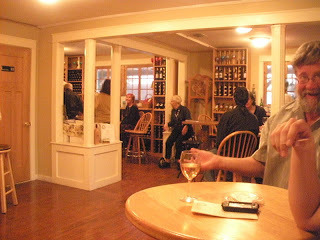
 My Daughter's Gourmet Creations
My Daughter's Gourmet Creations
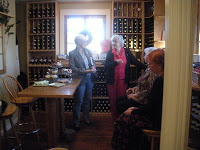 I had a very successful Book Launch/Wine Tasting event a few days ago, to celebrate the release of my new historical novel, The Tapestry Shop. Since it's set in France, I thought a winery was the perfect place to have it. We had the whole area to ourselves, and the owner closed to the public. Invited guests ranged from librarians to author friends, and included family as well as my golfer friends. A local bookstore sold my books so I didn't have to do anything but sign, which was wonderful because it gave me time to talk to everyone. Besides snacks and good wine, we munched on these fantastic creations which are my daughter's specialty, her tasses de chocolat avec fruits et gâteau , shown here. Because the book is based on the life of a French poet/musician, I thought we needed music too. While it wasn't authentic period music, a husband-and-wife team brought dulcimers and a guitar, which was perfect background music for a medieval atmosphere. This was a first for me, but it certainly won't be the last. I'll post more images of the event on my Facebook Author Page, http://tinyurl.com/2dyqemv .
I had a very successful Book Launch/Wine Tasting event a few days ago, to celebrate the release of my new historical novel, The Tapestry Shop. Since it's set in France, I thought a winery was the perfect place to have it. We had the whole area to ourselves, and the owner closed to the public. Invited guests ranged from librarians to author friends, and included family as well as my golfer friends. A local bookstore sold my books so I didn't have to do anything but sign, which was wonderful because it gave me time to talk to everyone. Besides snacks and good wine, we munched on these fantastic creations which are my daughter's specialty, her tasses de chocolat avec fruits et gâteau , shown here. Because the book is based on the life of a French poet/musician, I thought we needed music too. While it wasn't authentic period music, a husband-and-wife team brought dulcimers and a guitar, which was perfect background music for a medieval atmosphere. This was a first for me, but it certainly won't be the last. I'll post more images of the event on my Facebook Author Page, http://tinyurl.com/2dyqemv .
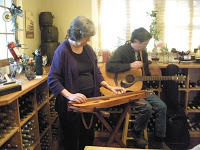 Donna and Jeff, local musicians
Donna and Jeff, local musicians
Published on November 13, 2010 12:08
October 31, 2010
Renaissance Tapestry Exhibition
 Most people who enjoy tapestries display them on a wall, but many people don't realize the practical use of tapestries in times past. Tapestries have been around for hundreds of years, even in ancient civilizations, where they not only decorated the royal residence, and were hung around the royal bed for privacy, but were also used for burying the dead.
Most people who enjoy tapestries display them on a wall, but many people don't realize the practical use of tapestries in times past. Tapestries have been around for hundreds of years, even in ancient civilizations, where they not only decorated the royal residence, and were hung around the royal bed for privacy, but were also used for burying the dead. During the medieval period, churches recognized the powerful impact a Biblical scene would have on a congregation who could neither read nor write. Between that, and the show of grandeur that every European court craved, the tapestry industry thrived. Tapestries became so coveted that they were considered war prizes, and were taken by conquering armies and brought back to their country. This makes it almost impossible to trace the origin of rare tapestries, unless the artist depicted a recognizable scene, city, or siege.
Paris was the first city to open factories for the production of tapestries, most notably the Gobelins factory. During the Hundred Years Was, weavers moved north and into Belgium. My historical novel, The Tapestry Shop, opens in Arras, France, a place so famed for its tapestries that the city name, arras, is now synonymous with the word tapestry. What I'd give to own one of those ancient tapestries, but of course they are in museums now, the few that exist, and are kept under carefully regulated temperature, light, and humidity.
For those of you within driving distance of Sarasota, Florida, the John Ringling Museum of Art has an exhibition of Renaissance tapestries from a museum in Vienna. The exhibition began in October and runs through Jan. 2, 2011. Here's the link http://www.ringling.org/Exhibitions2.aspx?id=8490 .
Published on October 31, 2010 09:53
October 17, 2010
Harpsichords in History
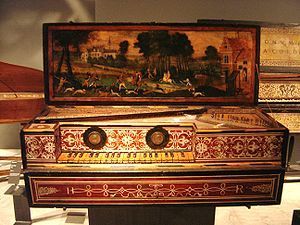
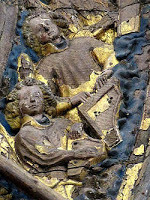 The distinctive sound produced by a harpsichord has always held a certain fascination for me. A solo instrument that somewhat resembles a piano, it predated the latter. The earliest representation of a harpsichord is from this sculpture (left), a 15th century altarpiece.
The distinctive sound produced by a harpsichord has always held a certain fascination for me. A solo instrument that somewhat resembles a piano, it predated the latter. The earliest representation of a harpsichord is from this sculpture (left), a 15th century altarpiece.Using the elements of the organ and psaltery (respectively, a keyboard, and metal strings held taut with tuning pins), the harpsichord gradually developed over time, with an increase in the size of the soundboard and keyboard.
The earliest extant harpsichord was made in Italy. During the 17th century, Flemish harpsichord builders added a second manual, a useful innovation to accommodate transposition (playing in another key) to accommodate a singer's vocal range.
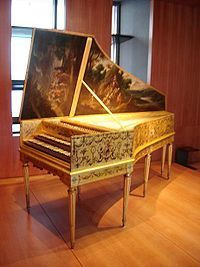 French makers expanded the two-manual instrument, and later, the English developed an instrument with brilliant treble and a more resonant bass, which contrasted with the more delicate sound of the French instrument, more like a woodwind sound.
French makers expanded the two-manual instrument, and later, the English developed an instrument with brilliant treble and a more resonant bass, which contrasted with the more delicate sound of the French instrument, more like a woodwind sound.With the invention of the piano, harpsichords fell out of favor, but the instrument became popular again during the twentieth century, and was frequently used in concerts to lend authenticity to music composed for the harpsichord.
During the 1950s, harpsichord kits came into vogue. Through the years, I've always wanted to get a kit and build one, but the task of assembling the kit sounded daunting. I'm hoping some day to own a harpsichord. I have CDs of harpsichord music, and the sound evokes an image of an 18th-century parlor, complete with an elaborately-dressed girl seated at the keyboard—wonderful background music for a Renaissance historical, don't you think?
Published on October 17, 2010 10:54
October 8, 2010
Serenades Through History
 I ask you, what can be more romantic than a serenade beneath your window? Even Romeo knew that, when courting Juliet. Do fraternities still serenade freshman girls below their dorm windows? I hope so, because scenes like that are the moments that make memories.
I ask you, what can be more romantic than a serenade beneath your window? Even Romeo knew that, when courting Juliet. Do fraternities still serenade freshman girls below their dorm windows? I hope so, because scenes like that are the moments that make memories. During the 13th century, singers and performers played an active role in politics, writing poems of praise to a leader, or creating satirical plays about local politicians. Not to be outdone, there were also women composers of courtly love songs. The women were known as troubaritz, and they wrote songs and sometimes performed them in court or at secular public gatherings.
In my October release, The Tapestry Shop, the main character, Adam, is a trouvere, a poet/musician in northern France, similar to the troubadours of southern France. His songs draw the attention of a magistrate, which leads to a trail of difficulties. Later, when Adam meets Catherine in a tapestry shop, there is an instant attraction, but he later learns that she will join the crusades, a mission he does not support.
Do any of you have a memory of being sung to? If so, I'd love to hear about it, so leave a comment. Who knows? You may find yourself in one of my books, wearing a low-necked crimson gown trimmed with seed pearls, being entertained by a troubadour.
Snippets from early reviews for The Tapestry Shop:
from Renaissance Magazine: "The Tapestry Shop" brilliantly illuminates the nuances of daily medieval life … is highly recommended and will convince the reader to set out on a quest in search of additional historical fiction novels by Joyce Elson Moore.
from Romance Reviews Today: …meticulously researched … Beautifully written, this is an excellent novel for the fan of historical fiction.
Published on October 08, 2010 08:48
September 30, 2010
Katharine Ashe on Knights and Rogues
History's Lures
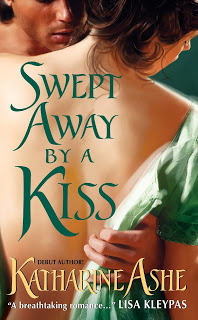 I am an author of historical romance. My debut Regency-era romance, SWEPT AWAY BY A KISS, features a scandalous beauty who finds herself imprisoned aboard a pirate ship with a dashing lord in disguise to fulfill a dangerous mission.
I am an author of historical romance. My debut Regency-era romance, SWEPT AWAY BY A KISS, features a scandalous beauty who finds herself imprisoned aboard a pirate ship with a dashing lord in disguise to fulfill a dangerous mission.
But, like my hero in SWEPT AWAY BY A KISS, I have two identities. Several times a week I don cap and gown (figuratively speaking) as a professor of medieval history.
These identities rarely mingle. My colleagues at the university don't know I write romance, and most of my writer friends don't much care that I'm a professor. But in my heart and soul they are inextricable. Because, like you, I simply adore history.
Allow me, if you will, to show you why.
In one 13th-century tale, a peasant's wife prepares for a visit from her lover, the local chaplain. But, oh no! Home comes her oafish husband from work in the middle of the day. He feels wretched, so she nurses him, eventually exclaiming that he must be dying. Settling him in bed, she hurries off to fetch the chaplain to give her poor husband his Last Rites. The chaplain arrives and blesses the peasant (but being a man of at least some scruples, he forebears saying the actual prayer for the dying). Soon enough wife and chaplain convince the gullible husband he's dead, and begin going at it in the straw nearby. The peasant hears noises, opens his eyes, sees the chaplain enjoying his wife, and shouts to the chaplain, "If I weren't dead, you certainly would catch hell." The chaplain assures him that if he weren't dead he wouldn't be there cuckolding him, and the peasant relapses into contented idiocy.
Then of course there are other sorts of stories of misbegotten lust. True stories.
Take the tale of Peter Abelard, the greatest scholar of the twelfth century who fell into a tangle of lust and love with the brilliant young woman he tutored. Theirs was a torrid affair, furtive between books and lessons, all in secret because Abelard could not marry; it would have ruined his career. Nevertheless, when Heloise became pregnant, he wed her. Discovering it, her guardian feared Abelard meant to hide her away in a convent, and hired a pair of thugs to visit the scholar. In the dark of night, they castrated him. Abelard and Heloise fled to monasteries, but her love never died, her passion remaining undimmed over the years for the man she could no longer have.
Not all medieval lust and love was bawdy or tragic, though. One story tells of a king who swore to his wife that if she bore a girl-child he would see it slain. Alas, the queen gave birth to a girl. So she dressed her daughter in boy's clothes and raised her as a prince. Then came the day her father betrothed her to a princess. As youth are wont to do, they fell in love. Moved by their attachment, Cupid intervened. Lo and behold, with a kiss the girl-prince became a man.
But I mustn't leave out a huge part of history's lure to me: the heroes.
One vastly popular story tells of the knight Owein's greatest adventure. Realizing he's spent his warrior's life sinning left and right, the valiant Owein seeks the entrance to Purgatory on earth. Finding it, he plunges in, taking only courage and unwavering faith with him. None of the fiery, vicious torments of the torture chambers can touch him, though. Confident, he walks out a stronger, more valiant knight for the purifying trials he has endured.
Finally, one of my favorites, a true story from a Muslim memoire. We all know of the Templars as mighty warriors. They fought for medieval Christendom like Green Berets today fight for America. And just as Green Berets, many Templars were men of great compassion and understanding too. During the crusades in a city occupied by Christian forces, one day a Muslim warrior entered a former mosque—converted to a church—to say his prayers. A French knight who'd just arrived in the East, full of the conceit of a foreigner, grabbed up the Muslim to throw him out. Five Templars drew swords and came to the Muslim's defense. They claimed the house of prayer must be for all.
Why do I love history? For its laughter, its passion, its stories of love and pure, unadulterated lust for life. For how it shows us bravery, courage and compassion are human traits, not confined to one era or one culture. For all its marvelous lures.
Why do you love history?
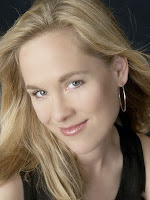 Katharine Ashe lives in the wonderfully warm Southeast with her husband, son, two dogs, and a garden she likes to call romantic rather than unkempt. A professor of European history, she has made her home in California, Italy, France, and the northern US. Booklist named Ashe one of the "New Stars of Historical Romance" and RT Book Reviews awarded her debut, Swept Away By A Kiss, a "TOP PICK!", calling it "a page-turner and a keeper." Please visit her at http://www.katharineashe.com/ , where she has a free Regency ghost novel for those of you who like a touch of haunting with your history.
Katharine Ashe lives in the wonderfully warm Southeast with her husband, son, two dogs, and a garden she likes to call romantic rather than unkempt. A professor of European history, she has made her home in California, Italy, France, and the northern US. Booklist named Ashe one of the "New Stars of Historical Romance" and RT Book Reviews awarded her debut, Swept Away By A Kiss, a "TOP PICK!", calling it "a page-turner and a keeper." Please visit her at http://www.katharineashe.com/ , where she has a free Regency ghost novel for those of you who like a touch of haunting with your history.
 I am an author of historical romance. My debut Regency-era romance, SWEPT AWAY BY A KISS, features a scandalous beauty who finds herself imprisoned aboard a pirate ship with a dashing lord in disguise to fulfill a dangerous mission.
I am an author of historical romance. My debut Regency-era romance, SWEPT AWAY BY A KISS, features a scandalous beauty who finds herself imprisoned aboard a pirate ship with a dashing lord in disguise to fulfill a dangerous mission. But, like my hero in SWEPT AWAY BY A KISS, I have two identities. Several times a week I don cap and gown (figuratively speaking) as a professor of medieval history.
These identities rarely mingle. My colleagues at the university don't know I write romance, and most of my writer friends don't much care that I'm a professor. But in my heart and soul they are inextricable. Because, like you, I simply adore history.
Allow me, if you will, to show you why.
In one 13th-century tale, a peasant's wife prepares for a visit from her lover, the local chaplain. But, oh no! Home comes her oafish husband from work in the middle of the day. He feels wretched, so she nurses him, eventually exclaiming that he must be dying. Settling him in bed, she hurries off to fetch the chaplain to give her poor husband his Last Rites. The chaplain arrives and blesses the peasant (but being a man of at least some scruples, he forebears saying the actual prayer for the dying). Soon enough wife and chaplain convince the gullible husband he's dead, and begin going at it in the straw nearby. The peasant hears noises, opens his eyes, sees the chaplain enjoying his wife, and shouts to the chaplain, "If I weren't dead, you certainly would catch hell." The chaplain assures him that if he weren't dead he wouldn't be there cuckolding him, and the peasant relapses into contented idiocy.
Then of course there are other sorts of stories of misbegotten lust. True stories.
Take the tale of Peter Abelard, the greatest scholar of the twelfth century who fell into a tangle of lust and love with the brilliant young woman he tutored. Theirs was a torrid affair, furtive between books and lessons, all in secret because Abelard could not marry; it would have ruined his career. Nevertheless, when Heloise became pregnant, he wed her. Discovering it, her guardian feared Abelard meant to hide her away in a convent, and hired a pair of thugs to visit the scholar. In the dark of night, they castrated him. Abelard and Heloise fled to monasteries, but her love never died, her passion remaining undimmed over the years for the man she could no longer have.
Not all medieval lust and love was bawdy or tragic, though. One story tells of a king who swore to his wife that if she bore a girl-child he would see it slain. Alas, the queen gave birth to a girl. So she dressed her daughter in boy's clothes and raised her as a prince. Then came the day her father betrothed her to a princess. As youth are wont to do, they fell in love. Moved by their attachment, Cupid intervened. Lo and behold, with a kiss the girl-prince became a man.
But I mustn't leave out a huge part of history's lure to me: the heroes.
One vastly popular story tells of the knight Owein's greatest adventure. Realizing he's spent his warrior's life sinning left and right, the valiant Owein seeks the entrance to Purgatory on earth. Finding it, he plunges in, taking only courage and unwavering faith with him. None of the fiery, vicious torments of the torture chambers can touch him, though. Confident, he walks out a stronger, more valiant knight for the purifying trials he has endured.
Finally, one of my favorites, a true story from a Muslim memoire. We all know of the Templars as mighty warriors. They fought for medieval Christendom like Green Berets today fight for America. And just as Green Berets, many Templars were men of great compassion and understanding too. During the crusades in a city occupied by Christian forces, one day a Muslim warrior entered a former mosque—converted to a church—to say his prayers. A French knight who'd just arrived in the East, full of the conceit of a foreigner, grabbed up the Muslim to throw him out. Five Templars drew swords and came to the Muslim's defense. They claimed the house of prayer must be for all.
Why do I love history? For its laughter, its passion, its stories of love and pure, unadulterated lust for life. For how it shows us bravery, courage and compassion are human traits, not confined to one era or one culture. For all its marvelous lures.
Why do you love history?
 Katharine Ashe lives in the wonderfully warm Southeast with her husband, son, two dogs, and a garden she likes to call romantic rather than unkempt. A professor of European history, she has made her home in California, Italy, France, and the northern US. Booklist named Ashe one of the "New Stars of Historical Romance" and RT Book Reviews awarded her debut, Swept Away By A Kiss, a "TOP PICK!", calling it "a page-turner and a keeper." Please visit her at http://www.katharineashe.com/ , where she has a free Regency ghost novel for those of you who like a touch of haunting with your history.
Katharine Ashe lives in the wonderfully warm Southeast with her husband, son, two dogs, and a garden she likes to call romantic rather than unkempt. A professor of European history, she has made her home in California, Italy, France, and the northern US. Booklist named Ashe one of the "New Stars of Historical Romance" and RT Book Reviews awarded her debut, Swept Away By A Kiss, a "TOP PICK!", calling it "a page-turner and a keeper." Please visit her at http://www.katharineashe.com/ , where she has a free Regency ghost novel for those of you who like a touch of haunting with your history.
Published on September 30, 2010 18:15



